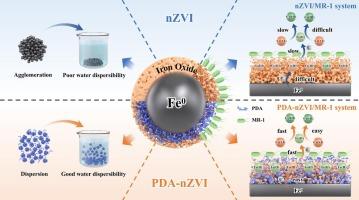Polydopamine as electron shuttle and dispersant: Unlocking nZVI reactivity coupled with Shewanella oneidensis MR-1 for efficient Cr(VI) removal
IF 9
1区 工程技术
Q1 ENGINEERING, CHEMICAL
引用次数: 0
Abstract
The inherent limitations of nano zero-valent iron (nZVI) severely limit its widespread application in heavy metal pollution remediation. To address this, Shewanella oneidenis MR-1 (MR-1) was utilized to counteract the iron oxide passivation layer on nZVI surface, however, this approach suffered from low electron transfer rate between MR-1 and the passivation layer. In this research, a novel PDA-modified nZVI composite (PDA-nZVI) was synthesized. Compared to unmodified nZVI, the proportions of Fe0 and Fe(II) on the PDA-nZVI surface increased 2.06 % and 21.63 %, respectively. The electrochemical tests (e.g., a more negative corrosion potential, a lower charge-transfer resistance, a higher current density, and a 3.4-times larger electrochemical active surface area for PDA-nZVI compared to nZVI) confirm that PDA enhances electron transfer from iron core to the outside, thereby promoting Fe0 availability and Fe(II) generation on the PDA-nZVI surface. Meanwhile, PDA modification successfully enhanced the material's dispersibility and hydrophilicity in aqueous solutions. Results demonstrate that the Cr(VI) elimination capacity of the PDA-nZVI and MR-1 combined system (PDA-nZVI/MR-1) was markedly superior to that of the nZVI/MR-1 system. Mechanism analyses demonstrate that PDA can act as an electron shuttle to accelerate electron transfer between MR-1 and the passivation layer, thereby promoting more Fe(III) transformation to Fe(II). This process enables more Cr(VI) to be reduced to Cr(III), which is subsequently adsorbed or complexed on the material surface as Cr2O3/FeCr2O4 and CrxFe1-x(OH)3, ultimately being removed from the solution via co-precipitation. The PDA-nZVI/MR-1 system successfully overcomes the inherent limitations and exhibits an exceptional Cr(VI) elimination capability


聚多巴胺作为电子穿梭和分散剂:解锁nZVI反应性,与希瓦氏菌MR-1结合,有效去除Cr(VI)
纳米零价铁(nZVI)的固有局限性严重限制了其在重金属污染修复中的广泛应用。为了解决这个问题,利用希瓦氏菌MR-1 (MR-1)来中和nZVI表面的氧化铁钝化层,但这种方法存在MR-1与钝化层之间的电子转移率低的问题。本研究合成了一种新型的pda修饰的nZVI复合材料(PDA-nZVI)。与未改性的nZVI相比,PDA-nZVI表面Fe0和Fe(II)的比例分别提高了2.06 %和21.63 %。电化学测试(例如,与nZVI相比,PDA-nZVI具有更负的腐蚀电位、更低的电荷转移电阻、更高的电流密度和3.4倍的电化学活性表面积)证实,PDA增强了电子从铁芯向外部的转移,从而促进了PDA-nZVI表面的Fe0可用性和Fe(II)的生成。同时,PDA改性成功地提高了材料在水溶液中的分散性和亲水性。结果表明,PDA-nZVI与MR-1联合体系(PDA-nZVI/MR-1)对Cr(VI)的消除能力明显优于nZVI/MR-1体系。机理分析表明,PDA可以作为电子穿梭器,加速MR-1与钝化层之间的电子传递,从而促进更多的Fe(III)向Fe(II)转变。该过程使更多的Cr(VI)被还原为Cr(III),随后在材料表面以Cr2O3/FeCr2O4和CrxFe1-x(OH)3的形式吸附或络合,最终通过共沉淀从溶液中去除。PDA-nZVI/MR-1系统成功地克服了固有的局限性,并表现出优异的Cr(VI)消除能力
本文章由计算机程序翻译,如有差异,请以英文原文为准。
求助全文
约1分钟内获得全文
求助全文
来源期刊

Separation and Purification Technology
工程技术-工程:化工
CiteScore
14.00
自引率
12.80%
发文量
2347
审稿时长
43 days
期刊介绍:
Separation and Purification Technology is a premier journal committed to sharing innovative methods for separation and purification in chemical and environmental engineering, encompassing both homogeneous solutions and heterogeneous mixtures. Our scope includes the separation and/or purification of liquids, vapors, and gases, as well as carbon capture and separation techniques. However, it's important to note that methods solely intended for analytical purposes are not within the scope of the journal. Additionally, disciplines such as soil science, polymer science, and metallurgy fall outside the purview of Separation and Purification Technology. Join us in advancing the field of separation and purification methods for sustainable solutions in chemical and environmental engineering.
 求助内容:
求助内容: 应助结果提醒方式:
应助结果提醒方式:


